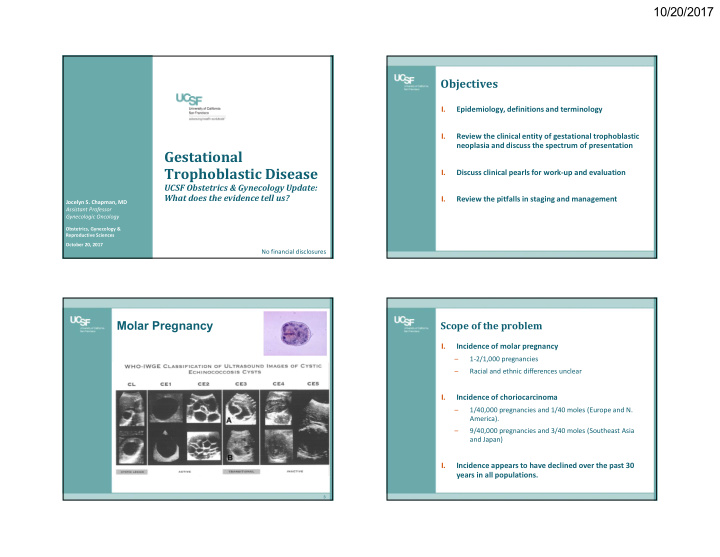



10/20/2017 Objectives I. Epidemiology, definitions and terminology I. Review the clinical entity of gestational trophoblastic neoplasia and discuss the spectrum of presentation Gestational Trophoblastic Disease I. Discuss clinical pearls for work-up and evaluation UCSF Obstetrics & Gynecology Update: What does the evidence tell us? I. Review the pitfalls in staging and management Jocelyn S. Chapman, MD Assistant Professor Gynecologic Oncology Obstetrics, Gynecology & Reproductive Sciences October 20, 2017 No financial disclosures Molar Pregnancy Scope of the problem I. Incidence of molar pregnancy – 1-2/1,000 pregnancies – Racial and ethnic differences unclear I. Incidence of choriocarcinoma – 1/40,000 pregnancies and 1/40 moles (Europe and N. America). – 9/40,000 pregnancies and 3/40 moles (Southeast Asia and Japan) I. Incidence appears to have declined over the past 30 years in all populations. 3 1
10/20/2017 Risk Factors for Complete Hydatidiform Mole Risk Factors for Choriocarcinoma I. Prior complete hydatidiform mole (1,000 times more likely than reference) I. Extremes of maternal age (1.9 times higher than reference) II. Asian, American Indian and African American ethnicities (?) I. Prior molar pregnancy (10-20 times higher than reference) I. History of SAB (2-3 fold higher than reference) Where does this disease start? 4 GTDs and 3 GTNs • Hydatiform mole – Complete (15-20% risk of GTN) – Partial (1-5% risk of GTN) • Invasive mole • Choriocarcinoma • Placental site trophoblastic tumor (PSTT) 2
10/20/2017 Clinical & pathologic features of GTD Partial versus complete moles Human chorionic gonadotropin (HCG) 6 Types of hCG in serum 3
10/20/2017 The problem of phantom hCG Three ways to rule out phantom HCG I. Run the serum HCG assay on a urine specimen. – Antibodies are filtered out in urine I. Request serial dilution. – If there is TRUE GTN then serial dilution should result in a parallel DECREASE in HCG. – If the HCG result is a false positive, serial dilution should NOT show a parallel decrease with dilution. I. Send urine and blood to the USA hCG Reference laboratory (hcglab.com). Include the following in your work-up How to diagnose post-molar GTN? for GTN I. hCG plateau for 4 consecutive values over 3 weeks I. Complete history and examination II. hCG rise of >/= 10% for 3 values over 2 weeks I. CBC, coags, chemistries, LFTs, TFTs, blood type, Rh status, quantitative hCG – Rhogam? III. hCG persistence 6 months after molar evacuation II. Imaging: CXR and ultrasound IV. Histopathologic diagnosis of choriocarcinoma – CT abdomen and pelvis – CT chest if CXR negative V. Presence of metastatic disease – Brain imaging if there are chest mets 15 4
10/20/2017 Don’t forget these things when taking a Should hysterotomy or IOL ever be suspected GTN case to the OR. considered? I. Uterotonics II. 12-14mm canula – Start at the internal cervix – Ultrasound guidance Hysterotomy & IOL III. Type and Cross IV. Can consider hysterectomy – Completed childbearing – Decreases risk for local persistent disease – Treatment of choice for PSTT. – Risk of post-molar GTN 3-5% so must have surveillance. 18 Staging GTN Treatment of Choriocarcinoma • Low-risk: prognostic score <7 – Methotrexate (MTX) +/- leucovorin rescue • Weekly IM MTX (30-50mg/m2) easiest dosing and lowest side effects but higher failure rates. • MTX 0.4mg/m2 IM/IV daily for 5 days every 2 weeks is most effective. – Actinomycin-D (ACT-D) • High-risk: prognostic score ≥7 – EMA/CO: etoposide, MTX, ACT-D, cyclophosphamide, vincristine – MAC: MTX, ACT-D, cyclophosphamide • These tumors are VERY chemosensitive! 5
10/20/2017 Chemotherapy works! Follow-up • Check hCG monthly x 12 months – Risk of relapse in the first year is 3% – Risk of relapse after the first year is exceedingly low • Oral contraceptives – Suppresses LH • Subsequent pregnancy – 1-2% risk of 2 nd GTN event – Pelvic U/S in 1 st trimester – Placenta goes to pathology – Check bHCG 6 weeks after delivery 22 Subsequent Pregnancy Outcome A Case Prior Molar pregnancy Complete Partial Total pregnancies 1254 218 Total deliveries 962 167 • 16 wks GA Term 68.7% 74.3% • Presents with: abdominal Preterm 7.4% 1.8% pain, n/v, headache Stillbirth 0.6% 0.5% • U/S consistent with molar pregnancy Spontaneous abortion 17.8% 16.1% • bHCG 400,000 Elective abortion 3.2% 5.0% Ectopic 0.9% 0.5% Repeat Mole 1.4% 1.8% Garner, Contemp Obstet Gynecol 2001 24 6
10/20/2017 A Case (cont.) Conclusions • GTN is curable • Think about the possibility of phantom hCG • Don’t forget your OR checklist • Call your friendly Gyn-Oncologist to help with management and treatment • Remember the principles of follow-up & counseling for future conceptions. 25 Question #1 Question #2 Which of the following is TRUE when taking a TRUE OR FALSE: Partial moles are more likely than patient with a suspected molar pregnancy for D&C? complete moles to progress to GTN. 90% 88% A. A type and screen is sufficient for A. True pre-op laboratory evaluation. B. False FALSE B. Sharp curettage is better than suction curettage. C. Uterotonics should be available. 6% 4% 13% Uterotonics should be av... A type and screen is suffi... Sharp curettage is better... e e u s l r a T F 7
10/20/2017 Question #3 TRUE OR FALSE: A patient with a persistent bHCG Questions? between 40 - 60 IUs/L, normal menses and no evidence of GTD on imaging should be given methotrexate. FALSE 74% A. True B. False 26% e e u s r a l T F 8
Recommend
More recommend